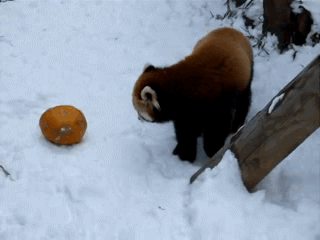A lot of authors write about how their characters have a mind of their own, always choosing their own path and making a mess of the story the writer was trying to write. Most advise allowing the characters to carve out their own way, under the assumption that these characters (aka your subconscious) probably know what they're doing. I think most would also agree, however, that sometimes you need to whip your characters into shape.
I find that my characters, while still in my head, are a lot like red pandas. Adorable, spunky, and not entirely sure what's going on. I also think that red pandas can teach us a lot about building great characters, so here are some of my strategies for building characters with red pandas.
1. If you surprise your characters, sometimes they do funny things.
Red pandas are masters of the art of escape. They are great at climbing and swimming, and are energetic and curious. It's called personality.
Surprising your character can mean anything from introducing or killing off another character, throwing them into an unexpected situation, or telling them something about themselves that they didn't already know (I AM YOUR FATHER). When you do this you give yourself opportunities for more character development, and also learn something about them along the way.
2. Every character needs a challenge.
Red pandas do well in captivity, but in the wild, their survival is threatened by poaching, habitat degradation, and deforestation.
Even minor characters need a challenge, whether it's something as simple as figuring out how to open a door, or something as complicated as being in a relationship. Challenges are what make us who we are as humans, and challenges provide depth for even the most minor characters.
3. Give each character a thing.
Fun fact: red pandas aren't pandas. They actually have their own family, which is part of the superfamily that includes raccoons and weasels.
Give each character a thing. This thing might be a tic of some sort, a weird piece of clothing that they wear, a turn of phrase that they frequently use, a common hand gesture, an unusual facial feature, or any other thing. This thing will help ground your character, both for you and the reader. Remember, your readers don't know your characters as well as you do, so having a thing can help them keep your characters from blurring together, particularly at the beginning of a piece. It can also give you something to ground yourself as you move forward with developing the character.
4. Where did they come from? Who did they used to be?
Red pandas live at an altitude between 7,200 and 15,700 feet. They like a mix of conifer and deciduous trees, and prefer temperatures between 50 and 75 degrees F. Don't we all.
I have a history. You have a history. The only people who don't have a history are people in witness protection and/or criminals that have managed to erase their identities. And even then, they still have a history, it's just a secret. History can equal a variety of things: people you've known, things you've done, education, family, friends, old apartments, jobs, etc. Your character has one of these too. Now, you may not need to know every detail of a character's life, but you should have a general idea of who they are and what they've been through. These details come through in dialogue, actions, and decisions, no matter how small.
5. Something in the way you move.........*
Red pandas have shorter front legs. This gives them a waddling gait, which is absolutely adorable.
Every individual has a distinctive style of movement. This is something I am working on incorporating into my characters. Non-verbal communication is as important as dialogue. For example, a person that is defensive might cross their arms and hunch forward. But a person trying to make himself look bigger or more intimidating might also cross his arms, but he would lift his head and push his shoulders back. What unique patterns of movement do your characters have that differentiate them from each other and from characters in other books?
We all know that the characters in our books aren't real... but what if they are? This is one of my favourite thought experiments. What if every book I write, every story, every idea, creates a pocket universe where my characters live and breathe and exist? What if I'm creating a window to a parallel universe? What if the voices in my head are real?
Then it is my responsibility to treat them as people. Give them voices. Don't sell them short. Give them the best representation of who they are that I can. After all, characters are people, too.






